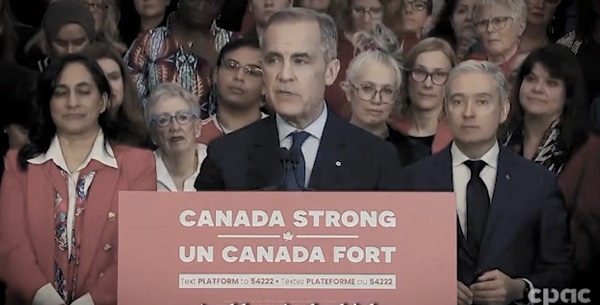Alberta
Tens of thousands of jobs set after Keystone XL makes deal with U.S. Unions

From TC Energy
Keystone XL Announces Project Labor Agreement with Four U.S. Unions
Creates Multi-Million Dollar Training Program for Renewable Energy Sector
TC Energy Corporation (TSX, NYSE: TRP) (TC Energy) announced today that Keystone XL has reached a project labor agreement (PLA) with four leading U.S. labor unions that will inject hundreds of millions of dollars in middle-class wages into the American economy, while ensuring this pipeline will be built by the highest-skilled and highest-trained workforce.
TC Energy is also working with labor to establish a unique Green Jobs Training Program to help union members acquire the specific skills needed to work in the developing renewable energy sector. The company will contribute approximately $10 million, recognizing the 10 million-plus hours anticipated to be worked on Keystone XL by union workers, to establish new training courses for current and future union members in North America.
“We are proud to partner with these union trades and craft workers to ensure this pipeline will be built by qualified professionals with specialized skills to the highest safety and quality standards,” said Richard Prior, President of Keystone XL. “We are especially proud of the new Green Jobs Training Program, which is an investment in thousands of current and future union workers.”
The four unions that are part of the PLA include the Laborers International Union of North America (LiUNA), the International Brotherhood of Teamsters, the International Union of Operating Engineers, and the United Association of Union Plumbers and Pipefitters. Each union is respected throughout the energy industry for their commitment to safety and quality.
“We’re proud to reach today’s agreement with TC Energy that will put UA members to work on this project, bringing safe and efficient energy to American families,” said Mark McManus, General President of the United Association of Union Plumbers and Pipefitters (UA). “This project will bring good paying jobs to our members, all while keeping energy costs low and delivering a boost to local communities and their economies. We’re ready to get to work.”
Project construction will support the creation of 42,000 family-sustaining jobs in the U.S, including more than 10,000 high-paying construction jobs that will be filled primarily by union workers. Keystone XL pipeline construction will generate $2 billion in earnings for U.S. workers, according to the 2014 Final Environmental Impact Statement done by the U.S. State Department.
“Unions working in the pipeline industry, like the Operating Engineers, pride themselves on achieving the highest level of technical training and safety to earn opportunities to build projects like Keystone XL,” said James T. Callahan, General President of the International Union of Operating Engineers. “When our members build and maintain pipelines, they are built right, built safe, and built to last. North America is in desperate need of more modern, safe and efficient energy infrastructure. Operating Engineers will continue to provide the most advanced training in the industry to ensure that these projects are built to the highest safety and environmental standards by the most skilled workforce possible.”
The agreement also underscores TC Energy’s commitment to hire as many local workers as possible, including Indigenous workers. Under the agreement, the unions will hire a tribal consultant to serve as a liaison, reaching out with job fairs and open houses to identify and support Indigenous members seeking to work on this project.
“The Keystone XL pipeline project will put thousands of Americans, including Teamsters, to work in good union jobs that will support working families,” said Jim Hoffa, Teamsters General President. “We believe in supporting projects which prioritize the creation of good jobs through much-needed infrastructure development.”
Keystone XL will create jobs and energy security in North America, by ensuring a reliable source of crude oil to the United States. Construction of Keystone XL will inject approximately $3.4 billion into the U.S. GDP. Once complete, Keystone XL will continue to contribute to the local economy, adding approximately $55 million in property taxes to local communities in Montana, South Dakota and Nebraska during the first year of operation.
For additional information on the project, visit Keystone-XL.com
Alberta
CPP another example of Albertans’ outsized contribution to Canada

From the Fraser Institute
By Tegan Hill
Amid the economic uncertainty fuelled by Trump’s trade war, its perhaps more important than ever to understand Alberta’s crucial role in the federation and its outsized contribution to programs such as the Canada Pension Plan (CPP).
From 1981 to 2022, Albertan’s net contribution to the CPP—meaning the amount Albertans paid into the program over and above what retirees in Alberta received in CPP payments—was $53.6 billion. In 2022 (the latest year of available data), Albertans’ net contribution to the CPP was $3.0 billion.
During that same period (1981 to 2022), British Columbia was the only other province where residents paid more into the CPP than retirees received in benefits—and Alberta’s contribution was six times greater than B.C.’s contribution. Put differently, residents in seven out of the nine provinces that participate in the CPP (Quebec has its own plan) receive more back in benefits than they contribute to the program.
Albertans pay an outsized contribution to federal and national programs, including the CPP because of the province’s relatively high rates of employment, higher average incomes and younger population (i.e. more workers pay into the CPP and less retirees take from it).
Put simply, Albertan workers have been helping fund the retirement of Canadians from coast to coast for decades, and without Alberta, the CPP would look much different.
How different?
If Alberta withdrew from the CPP and established its own standalone provincial pension plan, Alberta workers would receive the same retirement benefits but at a lower cost (i.e. lower CPP contribution rate deducted from our paycheques) than other Canadians, while the contribution rate—essentially the CPP tax rate—to fund the program would likely need to increase for the rest of the country to maintain the same benefits.
And given current demographic projections, immigration patterns and Alberta’s long history of leading the provinces in economic growth, Albertan workers will likely continue to pay more into the CPP than Albertan retirees get back from it.
Therefore, considering Alberta’s crucial role in national programs, the next federal government—whoever that may be—should undo and prevent policies that negatively impact the province and Albertans ability to contribute to Canada. Think of Bill C-69 (which imposes complex, uncertain and onerous review requirements on major energy projects), Bill C-48 (which bans large oil tankers off B.C.’s northern coast and limits access to Asian markets), an arbitrary cap on oil and gas emissions, numerous other “net-zero” targets, and so on.
Canada faces serious economic challenges, including a trade war with the United States. In times like this, it’s important to remember Alberta’s crucial role in the federation and the outsized contributions of Alberta workers to the wellbeing of Canadians across the country.
Alberta
Made in Alberta! Province makes it easier to support local products with Buy Local program

Show your Alberta side. Buy Local. |
When the going gets tough, Albertans stick together. That’s why Alberta’s government is launching a new campaign to benefit hard-working Albertans.
Global uncertainty is threatening the livelihoods of hard-working Alberta farmers, ranchers, processors and their families. The ‘Buy Local’ campaign, recently launched by Alberta’s government, encourages consumers to eat, drink and buy local to show our unified support for the province’s agriculture and food industry.
The government’s ‘Buy Local’ campaign encourages consumers to buy products from Alberta’s hard-working farmers, ranchers and food processors that produce safe, nutritious food for Albertans, Canadians and the world.
“It’s time to let these hard-working Albertans know we have their back. Now, more than ever, we need to shop local and buy made-in-Alberta products. The next time you are grocery shopping or go out for dinner or a drink with your friends or family, support local to demonstrate your Alberta pride. We are pleased tariffs don’t impact the ag industry right now and will keep advocating for our ag industry.”
Alberta’s government supports consumer choice. We are providing tools to help folks easily identify Alberta- and Canadian-made foods and products. Choosing local products keeps Albertans’ hard-earned dollars in our province. Whether it is farm-fresh vegetables, potatoes, honey, craft beer, frozen food or our world-renowned beef, Alberta has an abundance of fresh foods produced right on our doorstep.
Quick facts
- This summer, Albertans can support local at more than 150 farmers’ markets across the province and meet the folks who make, bake and grow our food.
- In March 2023, the Alberta government launched the ‘Made in Alberta’ voluntary food and beverage labelling program to support local agriculture and food sectors.
- Through direct connections with processors, the program has created the momentum to continue expanding consumer awareness about the ‘Made in Alberta’ label to help shoppers quickly identify foods and beverages produced in our province.
- Made in Alberta product catalogue website
Related information
-

 2025 Federal Election2 days ago
2025 Federal Election2 days agoCarney’s Fiscal Fantasy: When the Economist Becomes More Dangerous Than the Drama Teacher
-

 2025 Federal Election1 day ago
2025 Federal Election1 day agoCampaign 2025 : The Liberal Costed Platform – Taxpayer Funded Fiction
-

 International11 hours ago
International11 hours agoPope Francis has died aged 88
-

 2025 Federal Election1 day ago
2025 Federal Election1 day agoA Perfect Storm of Corruption, Foreign Interference, and National Security Failures
-

 Business11 hours ago
Business11 hours agoCanada Urgently Needs A Watchdog For Government Waste
-

 Energy11 hours ago
Energy11 hours agoIndigenous-led Projects Hold Key To Canada’s Energy Future
-

 2025 Federal Election10 hours ago
2025 Federal Election10 hours agoCarney’s budget means more debt than Trudeau’s
-

 International7 hours ago
International7 hours agoPope Francis Dies on Day after Easter








